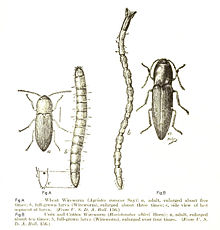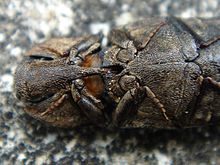- Click beetle
-
Click beetles 
Click beetle adults and larvae (wireworms)
Left: Wheat Wireworm (Agriotes mancus)
Right: Sand Wireworm (Horistonotus uhlerii)Scientific classification Kingdom: Animalia Phylum: Arthropoda Class: Insecta Order: Coleoptera Superfamily: Elateroidea Family: Elateridae
Leach, 1815Subfamilies Agrypninae
Anischiinae
Aplastinae
Cardiophorinae
Cebrioninae Latreille, 1802
Dendrometrinae
Denticollinae
Dicronychinae
Elaterinae
Hypnoidinae
Lissominae
Melanotinae
Negastriinae
Prosterninae
Subprotelaterinae
ThylacosterninaeSynonyms Campylidae
Cavicoxumidae
Ludiidae
Monocrepidiidae
Pangauridae
PhyllophoridaeThe family Elateridae is commonly called click beetles (or "typical click beetles" to distinguish them from the related Cerophytidae and Eucnemidae), elaters, snapping beetles, spring beetles or "skipjacks". They are a cosmopolitan beetle family characterized by the unusual click mechanism they possess. There are a few closely related families in which a few members have the same mechanism, but all elaterids can click. A spine on the prosternum can be snapped into a corresponding notch on the mesosternum, producing a violent "click" which can bounce the beetle into the air. Clicking is mainly used to avoid predation, although it is also useful when the beetle is on its back and needs to right itself. There are about 9300 known species worldwide,[1] and 965 valid species in North America.[2]
Contents
Description and ecology
Click beetles can be large and colorful (e.g. Selatosomus cruciatus), but most are small to medium-sized (<2 cm) and dull. The adults are typically nocturnal and phytophagous, but rarely of economic importance. In hot weather, they may enter people's houses at night if entries or windows are left opened but are not a pest. Click beetle larvae, called wireworms, are usually saprophagous, but some species are serious agricultural pests, and other species are predators of other insect larvae. A few elaterid species are bioluminescent (in both larvae and adult forms), such as Pyrophorus.
Larvae are slender, elongate, cylindrical or somewhat flattened, and relatively hard-shelled for larvae—bearing resemblance to common mealworms (tenebrionid larvae; e.g. Tenebrio molitor). The three pairs of legs on the thoracic segments are short and the last abdominal segment is, as is frequently the case in beetle larvae, directed downwards and may serve as a terminal proleg in some species. The posterior end of the body (9th abdominal segment) is pointed in larvae of Agriotes, Dalopius and Melanotus, but is bifid due to a so-called caudal notch in Selatosomus (formerly Ctenicera), Limonius, Hypnoides and Athous species.[3] The dorsum of the 9th abdominal segment may also have sharp processes (e.g. in Oestodini such as Drapetes spp. and Oestodes spp.). Although some species complete their development in one year (e.g. Conoderus), wireworms usually spend three or four years in the soil, feeding on decaying vegetation and the roots of plants, and often causing damage to agricultural crops such as potato, strawberry, corn, and wheat.[4][5] The subterranean habits of wireworms, their ability to quickly locate food by following carbon dioxide gradients produced by plant material in the soil,[6] and their remarkable ability to recover from illness induced by insecticide exposure (sometimes after many months),[7] make it hard to exterminate them once they have begun to attack a crop. Wireworms can pass easily through the soil on account of their shape and their propensity for following pre-existing burrows,[8] and can travel from plant to plant, thus injuring the roots of multiple plants within a short time.
Other subterranean creatures such as the leatherjacket grub of crane flies which have no legs, and geophilid centipedes, which may have over two hundred, are sometimes confounded with the six-legged wireworms.
Larvae of some Brazilian savanna species of click beetles live in burrows scattered over the surfaces of termite mounds using their bioluminescence to attract flying prey.
Selected genera
- Actenicerus
- Adelocera
- Adrastus
- Aeoloderma
- Aeoloides
- Aeolus
- Agriotes
- Agrypnus
- Alaus
- Ampedus
- Anchastus
- Anostirus
- Aplotarsus
- Athous
- Berninelsonius
- Betarmon
- Brachygonus
- Brachylacon
- Calambus
- Cardiophorus
- Chalcolepidus
- Cidnopus
- Conoderus
- Craspedostethus
- Crepidophorus
- Ctenicera
- Dacnitus
- Dalopius
- Danosoma
- Denticollis
- Diacanthous
- Dicronychus
- Dima
- Drasterius
- Eanus
- Ectamenogonus
- Ectinus
- Elater
- Elathous
- Eopenthes
- Fleutiauxellus
- Haterumelater
- Hemicleus
- Hemicrepidius
- Heteroderes
- Horistonotus
- Hypnoidus
- Hypoganus
- Hypolithus
- Idolus
- Idotarmonides
- Ischnodes
- Isidus
- Itodacne
- Jonthadocerus
- Lacon
- Lanelater
- Limoniscus
- Limonius
- Liotrichus
- Megapenthes
- Melanotus
- Melanoxanthus
- Metanomus
- Mulsanteus
- Negastrius
- Neopristilophus
- Nothodes
- Oedostethus
- Orithales
- Paracardiophorus
- Paraphotistus
- Peripontius
- Pheletes
- Pittonotus
- Pityobius
- Plastocerus
- Podeonius
- Porthmidius
- Procraerus
- Prodrasterius
- Prosternon
- Pseudanostirus
- Pyrophorus
- Quasimus
- Reitterelater
- Selatosomus
- Sericus
- Simodactylus
- Spheniscosomus
- Stenagostus
- Synaptus
- Tetrigus
- Zorochros
See also
References
- ^ Marielle Cristina Schneider, Mara Cristina Almeida, Simone Policena Rosa, Cleide Costa and Doralice Maria Cella (2006). "Evolutionary chromosomal differentiation among four species of Conoderus Eschscholtz, 1829 (Coleoptera, Elateridae, Agrypninae, Conoderini) detected by standart staining, C-banding, silver nitrate impregnation, and CMA3/DA/DAPI staining". Genetica 128 (1–3): 333–346. doi:10.1007/s10709-006-7101-5. PMID 17028962.
- ^ Christopher G. Majka & Paul J. Johnson (2008). "The Elateridae (Coleoptera) of the Maritime Provinces of Canada: faunal composition, new records, and taxonomic changes" (PDF excerpt). Zootaxa 1811: 1–33. http://www.mapress.com/zootaxa/2008/f/z01811p033f.pdf.
- ^ Wim van Herk (March 12, 2009). "Limonius: wireworm research site". http://www3.telus.net/limonius/Limonius.htm. Retrieved January 22, 2011.
- ^ R. S. Vernon, W. van Herk, J. Tolman, H. Ortiz Saavedra, M. Clodius & B. Gage (2008). "Transitional sublethal and lethal effects of insecticides after dermal exposures to five economic species of wireworms (Coleoptera: Elateridae)". Journal of Economic Entomology 101 (2): 365–374. doi:10.1603/0022-0493(2008)101[365:TSALEO]2.0.CO;2. PMID 18459400.
- ^ William E. Parker & Julia J. Howard (2001). "The biology and management of wireworms (Agriotes spp.) on potato with particular reference to the U.K.". Agricultural and Forest Entomology 3 (2): 85–98. doi:10.1046/j.1461-9563.2001.00094.x.
- ^ J. F. Doane, Y. W. Lee, N. D. Westcott & J. Klingler (1975). "The orientation response of Ctenicera destructor and other wireworms (Coleoptera: Elateridae) to germinating grain and to carbon dioxide". Canadian Entomologist 107 (12): 1233–1252. doi:10.4039/Ent1071233-12.
- ^ W. G. van Herk, R. S. Vernon, J. H. Tolman & H. Ortiz Saavedra (2008). "Mortality of a wireworm, Agriotes obscurus (Coleoptera: Elateridae), after topical application of various insecticides". Journal of Economic Entomology 101 (2): 375–383. PMID 18459401. http://www.ingentaconnect.com/content/esa/jee/2008/00000101/00000002/art00018.
- ^ Willem G. van Herk & Robert S. Vernon (2007). "Soil bioassay for studying behavioral responses of wireworms (Coleoptera: Elateridae) to inecticide-treated wheat seed". Environmental Entomology 36 (6): 1441–1449. doi:10.1603/0046-225X(2007)36[1441:SBFSBR]2.0.CO;2. PMID 18284772.
 Chisholm, Hugh, ed (1911). "Wireworm". Encyclopædia Britannica (11th ed.). Cambridge University Press.
Chisholm, Hugh, ed (1911). "Wireworm". Encyclopædia Britannica (11th ed.). Cambridge University Press.
External links
 Media related to Elateridae at Wikimedia Commons
Media related to Elateridae at Wikimedia Commons Data related to Click beetle at Wikispecies
Data related to Click beetle at Wikispecies- Elateridae
- Click beetles, Alaus spp. on the University of Florida / Institute of Food and Agricultural Sciences Featured Creatures website
- Taiwanese Site images binomial names
Categories:- Elateridae
- Elateroidea
- Insect families
Wikimedia Foundation. 2010.


